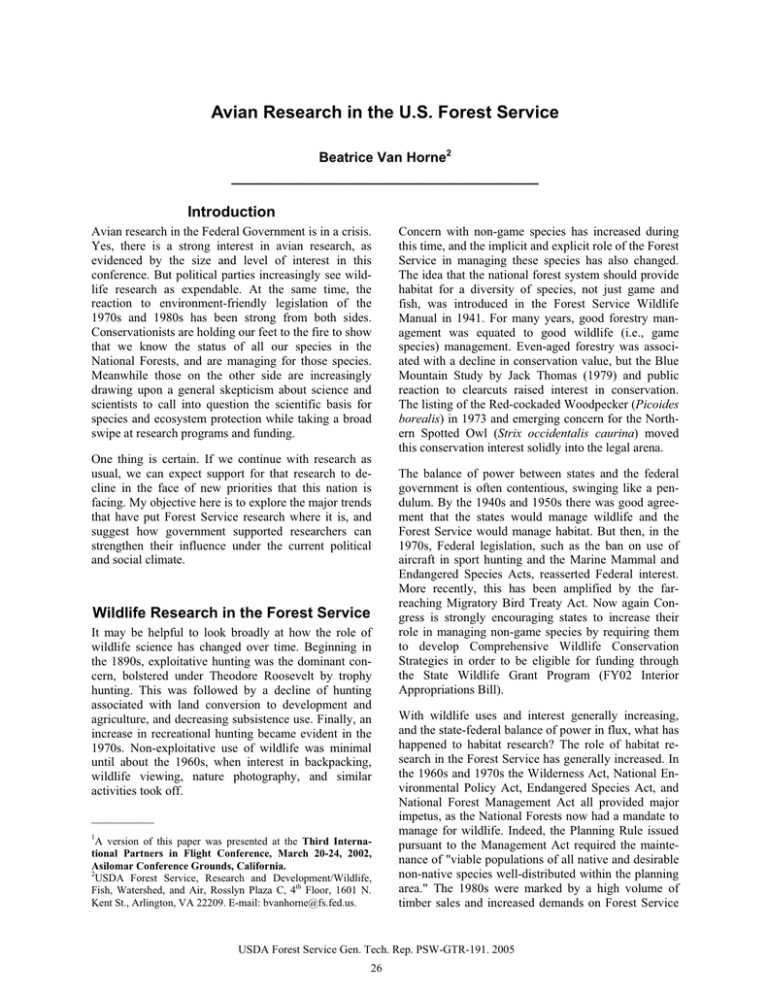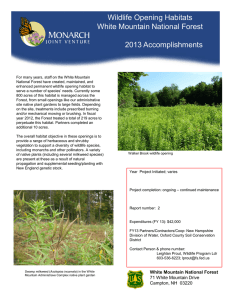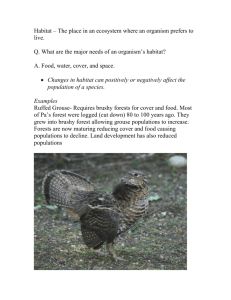Avian Research in the U.S. Forest Service Introduction Beatrice Van Horne ________________________________________
advertisement

Avian Research in the U.S. Forest Service Beatrice Van Horne2 ________________________________________ Introduction Avian research in the Federal Government is in a crisis. Yes, there is a strong interest in avian research, as evidenced by the size and level of interest in this conference. But political parties increasingly see wildlife research as expendable. At the same time, the reaction to environment-friendly legislation of the 1970s and 1980s has been strong from both sides. Conservationists are holding our feet to the fire to show that we know the status of all our species in the National Forests, and are managing for those species. Meanwhile those on the other side are increasingly drawing upon a general skepticism about science and scientists to call into question the scientific basis for species and ecosystem protection while taking a broad swipe at research programs and funding. One thing is certain. If we continue with research as usual, we can expect support for that research to decline in the face of new priorities that this nation is facing. My objective here is to explore the major trends that have put Forest Service research where it is, and suggest how government supported researchers can strengthen their influence under the current political and social climate. Wildlife Research in the Forest Service It may be helpful to look broadly at how the role of wildlife science has changed over time. Beginning in the 1890s, exploitative hunting was the dominant concern, bolstered under Theodore Roosevelt by trophy hunting. This was followed by a decline of hunting associated with land conversion to development and agriculture, and decreasing subsistence use. Finally, an increase in recreational hunting became evident in the 1970s. Non-exploitative use of wildlife was minimal until about the 1960s, when interest in backpacking, wildlife viewing, nature photography, and similar activities took off. __________ 1 A version of this paper was presented at the Third International Partners in Flight Conference, March 20-24, 2002, Asilomar Conference Grounds, California. 2 USDA Forest Service, Research and Development/Wildlife, Fish, Watershed, and Air, Rosslyn Plaza C, 4th Floor, 1601 N. Kent St., Arlington, VA 22209. E-mail: bvanhorne@fs.fed.us. Concern with non-game species has increased during this time, and the implicit and explicit role of the Forest Service in managing these species has also changed. The idea that the national forest system should provide habitat for a diversity of species, not just game and fish, was introduced in the Forest Service Wildlife Manual in 1941. For many years, good forestry management was equated to good wildlife (i.e., game species) management. Even-aged forestry was associated with a decline in conservation value, but the Blue Mountain Study by Jack Thomas (1979) and public reaction to clearcuts raised interest in conservation. The listing of the Red-cockaded Woodpecker (Picoides borealis) in 1973 and emerging concern for the Northern Spotted Owl (Strix occidentalis caurina) moved this conservation interest solidly into the legal arena. The balance of power between states and the federal government is often contentious, swinging like a pendulum. By the 1940s and 1950s there was good agreement that the states would manage wildlife and the Forest Service would manage habitat. But then, in the 1970s, Federal legislation, such as the ban on use of aircraft in sport hunting and the Marine Mammal and Endangered Species Acts, reasserted Federal interest. More recently, this has been amplified by the farreaching Migratory Bird Treaty Act. Now again Congress is strongly encouraging states to increase their role in managing non-game species by requiring them to develop Comprehensive Wildlife Conservation Strategies in order to be eligible for funding through the State Wildlife Grant Program (FY02 Interior Appropriations Bill). With wildlife uses and interest generally increasing, and the state-federal balance of power in flux, what has happened to habitat research? The role of habitat research in the Forest Service has generally increased. In the 1960s and 1970s the Wilderness Act, National Environmental Policy Act, Endangered Species Act, and National Forest Management Act all provided major impetus, as the National Forests now had a mandate to manage for wildlife. Indeed, the Planning Rule issued pursuant to the Management Act required the maintenance of "viable populations of all native and desirable non-native species well-distributed within the planning area." The 1980s were marked by a high volume of timber sales and increased demands on Forest Service USDA Forest Service Gen. Tech. Rep. PSW-GTR-191. 2005 26 Avian Research in the U.S. Forest Service - Van Horne biologists to provide information to support forest planning (Catton and Mighetto 1998). ences in their basic assumptions about the goals of management and research. Since the late 1980s, partnerships and challenge cost share have played a key role. This has engendered the rise of the marketing approach to science, in which specific research programs that have marketing appeal, such as "Partners in Flight," "Taking Wing" (wetland birds), "Making Tracks" (wild turkey), "Elk Country," "Full Curl" (wild sheep), "Dancers in the Forest" (grouse), "Answer the Call" (quail), "Bring Back Natives" (indigenous fish), "Animal Inn" (dead wood dependents), and others, are publicized. These partnerships foster funding through non-governmental organizations and other private sources, and have allowed for reduced federal funding for scientific research on wildlife of concern. Partnerships can influence research priorities and thereby make research less responsive to management needs. Research scientists may also be challenged in working with rugged individualists. One recent example arose when a few people caused a huge ruckus by deciding to violate scientific protocol in an effort to introduce some blind testing of lynx hair to a DNA lab. Some people assumed this was an effort to find evidence of lynx where they weren't, and, hence, to lock up the forests. Why did it take such a small match to light this conflagration? Apparently, people are at least paying attention to some wildlife research, and finding it to be important. On the other hand, scientists are no longer assumed to be "experts." It is increasingly recognized that scientific research is subject to criticism, and that any weakness can be exploited to invalidate unwanted results. This change has been recently addressed by the Data Quality Act, which allows the public to challenge the scientific basis of research results that are used to make management decisions. Researchers are now working in the spotlight, with their sampling designs, protocols, and statistical analyses are under the microscope as never before. Most recently, the awareness of issues of temporal and spatial scale, particularly the need to scale up, has increased. This was spurred by a move from singlespecies based research and management to a multispecies, ecosystem basis. In the 1960s and 1970s, we thought in terms of 40-200 acre clearcuts and 1-5 or 50-yr increments. Now we worry about ecosystems, 100-yr disturbances, 500-yr fire cycles, and, perhaps in our most enlightened moments, about maintaining genetic variation across evolutionarily-significant populations. So, we have a mixing of groups and points of view going on inside the Forest Service. At the same time, interest in Conservation and non-consumptive use of wildlife is increasing, evidenced partly by the laws protecting endangered species and rule providing habitat for viable populations of all species. Too often, monitoring and management of wildlife are insufficient to meet legal mandates. The net result is that the Forest Service ends up in court and can suffer costly delays in project implementation. The role of science and research, as well as the importance of scales of inference in time and space, is increasingly recognized. The task has overwhelmed resources, and decentralization of research has decreased our ability to coordinate over the large scale that we now know is important, while the collapsing of budget line items within Forest Service Research and Development has reduced funding accountability. So, the role of habitat research has generally increased, while our attention to the role of scale has exploded since 1980 or so, spurred by the development of Geographic Information Systems (GIS), a trend toward regional planning efforts, and recognition of the need to plan at large landscape levels during the Forest Planning process. I think it is useful to take a look at the sociology of the Forest Service during this period. The early, rugged individualist Forest Rangers were replaced by teams that sought to engineer habitat for game species, beginning with the Civilian Conservation Corps in the 1930s. After World War II, returning military staffed many forestry positions and were generally associated with an engineering approach and even-aged timber management. As these people retire, we have a diversity of groups made up of veterans, research biologists (mostly hired after 1970), environmental engineers, and rugged individualists. At the same time, ethnic and gender diversity has increased. This diversity has reinvigorated the Forest Service and presented some new challenges. There are difficulties in communication between research scientists and engineering and management-oriented individuals that stem from differ- Sometimes conflicts among groups with different interests can lead to paralysis or gridlock. But there is no gridlock for bird populations. So, I hope I have convinced you that we have a problem, and we have to break out of it. The solution does not lie with doing more of the same, only better: the problem is far too big for that. USDA Forest Service Gen. Tech. Rep. PSW-GTR-191. 2005 27 Avian Research in the U.S. Forest Service - Van Horne A Stronger Future for Avian Research What should we do? First, with the very small cadre of scientists we now have, choosing the most effective and high priority research problem is critical. Our strength is in long-term research that is integrated across basic science and management disciplines. At the same time, research results must produce outcomes that clearly influence decision-making in management. In this context, designing long-term research that will also produce intermediate products of direct interest to managers in meeting their immediate, most pressing needs is the best way to assure their support. For example, a study describing trends in bird populations and their habitats might be designed so that within 1-3 years it produces good solid bird-habitat information, by year 5 overall trend information, and by year 8 trends by habitat, made possible by increasing cumulative sample size. Research results must be communicated in a way that is useful to management and understood by the public, whether this is through userfriendly models, direct contact, input to the development of forest plans and management guidelines, or readable syntheses of research results. Second, we need to recast the way in which we, as research scientists, approach our research. We often carefully delineate the locale of inference, but this locale is not always matched to challenges faced by managers and decision-makers. Research not clearly linked to management problems or actions can lead to an impression that the choice of species, problems, and locations is haphazard or irrelevant. One partial solution to some of these dilemmas is to couple intensive research on avian population declines with broad-scale monitoring, thereby expanding the scope of inference. Research is more useful to management when the processes it elucidates are interpreted in the context of changes to the species, similar species, or related groups of interest across time and space. GIS has opened up a whole new world of spatially explicit variables that influence wildlife populations. Attempts to use such broad-based approaches to extrapolate the findings of local studies more widely must be coupled with an understanding of the processes driving the patterns in order to make predictions beyond the time and place in which data were collected. Increasingly, attempts at such extrapolation will be attacked in court unless they are based on underlying mechanisms. How can we improve the monitoring efforts that the National Forests are being legally directed to undertake and include in their Forest Plans? Research can help in determining which species are most important to monitor. Research can inform design, protocols, and verification, and maximize the useful information gained for each dollar spent. For example, what intensity of sampling do we need to detect a population decline of 10 percent? What is the best monitoring design to evaluate the results of management treatments? There are numerous examples of management treatments that are assumed to have a particular effect on wildlife; we should be testing such assumptions. This integration of monitoring and research would allow research to inform the monitoring design so that, for instance, it will be able to detect trends of some pre-determined magnitude with a specified level of statistical confidence. Monitoring could, in turn, provide a context for more intensive research. By designing monitoring with regard to management treatments, we can begin to investigate some management effects. What should scientists do when monitoring demonstrates that a bird species is in decline? Amassing habitat correlations is not sufficiently informative, although it may be a useful step. For example, correlations between Red-cockaded Woodpeckers and their habitat would not have been sufficient in themselves to identify the nesting requirements that were critical to population recovery. A Habitat Suitability Index model or an envirogram (Andrewartha and Birch 1984) may be a good place to start, as it is an effort to represent what is, or could be, limiting populations. Real progress is made when scientists are able to develop and investigate a hypothesis for the cause of a decline. The art is in knowing when there is enough information to develop useful hypotheses. Time and effort can be wasted on intensive studies that are initiated prematurely. Gathering reproduction and survival data may be helpful for understanding causes of decline in endangered, remnant species, such as spotted owls, but could be of limited use for more widespread species that might also be in decline. One should always remember that trends are often spatially explicit and quite likely habitat-specific. With monitoring information, we can evaluate the scale of the decline in time and space. Information from Breeding Bird Surveys and even Christmas Bird Counts is often used for this. There are serious biases in these data but these may be adequately compensated by the sheer volume of data. It may be useful to check whether similar species, that might be dependant on the same habitat features, are also declining. Research has several roles in the Forest Service, but monitoring has often been avoided. I think our ability to fulfill other roles will be compromised unless we help with the design and analyses of monitoring efforts that have been mandated by the courts as a prime way to satisfy management responsibilities to wildlife. I believe involvement in scientifically rigorous monitoring will be exciting for researchers. Monitoring may be one of the most valuable and useful technology USDA Forest Service Gen. Tech. Rep. PSW-GTR-191. 2005 28 Avian Research in the U.S. Forest Service - Van Horne good science that uses tight design, controls, and careful statistical analyses is more important than ever. A single case of sloppy science can bring excellent research into question. transfer tools available to assist with meeting desired future conditions and objectives. It is imperative, however, that monitoring designs have sufficient power to detect trends to warrant these efforts. Clearly, standardization of protocols, including prescriptions for measuring common covariates, will allow us to scale up from localized areas and Forests. By making data widely available and linked to GIS, we can facilitate this scaling-up process. The need for cooperation with agencies and other organizations is self-evident. It would be helpful to think carefully about how we structure the monitoring relative to various treatments and gradients-haphazard information defies our best efforts to extract important relationships. Finally, these monitoring efforts should be used as a springboard for more intensive studies of survival, reproduction, community structure, and the processes that influence them when such focus is needed. Acknowledgments G. Contreras, S. Foster, C. J. Ralph, and J. Wiens provided useful input to this manuscript. Literature Cited Andrewartha, H. G. and L. C. Birch. 1984. The ecological web: More on the distribution and abundance of animals. Chicago, IL: University of Chicago Press; 520 p. Catton, T. and L. Mighetto. 1998. The fish and wildlife job on the National Forests: A century of game and fish conservation, habitat protection, and ecosystem management. Washington, DC: Forest Service, U.S. Department of Agriculture; 455 p. I conclude by suggesting a few strategies for research in this new environment. Scientists should always consider their interface with monitoring efforts. Have a working Habitat Suitability Index model, envirogram, or other model that makes the processes that could regulate populations explicit. Avoid reliance on correlation alone. Think about process, but place this process-oriented work in a context by scaling up in space, and time by doing long-term work. And, finally, Thomas, J. W., editor. 1979. Wildlife habitats in managed forests: The Blue Mountains of Oregon and Washington. Agriculture Handbook No. 553. Washington, DC: U.S. Department of Agriculture, printed by Government Printing Office; 510 p. USDA Forest Service Gen. Tech. Rep. PSW-GTR-191. 2005 29

